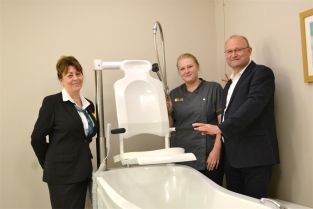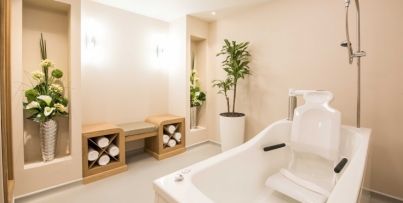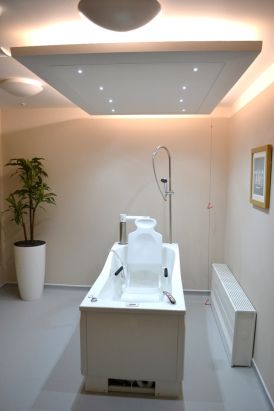Enhancing the bathing experience for someone with dementia in a care home or domestic environment
Category List
Active Bathing News (3)
Website (1)
Case Study (5)
Press Releases (2)
Care Home Baths (1)
Product News (3)
Archive
2019
Enhancing the bathing experience for someone with dementia in a care home or domestic environment
Jul 12, 2016
Personal care activities, including washing and bathing, are extremely private. They are a common source of anxiety for people with dementia and can be difficult for carers also. It is not hard to understand why - most of us have been managing this on our own from a young age and needing assistance from another person with something so personal raises many issues.
Augustus Court Care Home in Leeds was opened in February 2016 and features the latest in dementia friendly design and equipment from Active Bathing.
Part of this has been the installation of two Compact DC (Dementia Care) Height Adjustable Baths from Active Bathing which have proved to be very popular with staff and resident’s alike as Care Home Manager, Mary Usher explained:
“When we assess potential residents we find they have often only been having showers at home due to the accessibility of the bath, so many automatically say they prefer to shower. One lady came in to Augustus Court Care Home who had not had a bath for 20 years and when she had her first bath here in the Compact DC, she asked to be left alone for 10 minutes to have a soak and now requests a bath every other day.”
The design of the Compact DC bath makes bathing very relaxing for residents and staff; according to Mary:
“I have seen a lot of baths over the years where the water barely covers the person’s legs if they are lucky, but with this bath, the person is fully emerged in the water, enabling them to enjoy a relaxing soak and a bit of pampering".
To compliment the enhanced bathing experience the design team at Meridian also designed mood lighting to provide a truly therapeutic environment; Residents often comment on how relaxing the experience is. These days products are designed for the benefit of the resident and carer and a prime example of this is the height adjustable feature of the Compact DC. From a resident’s perspective it means that should hoisting be required, the bath can be lowered to enable the resident to be hoisted in and out of the bath safely and with dignity. When raised, the carer is able to bathe the resident without bending or crouching on the floor thereby risking back injury and potentially time off work.
12 Tips for helping someone with dementia wash:
- Try to make the experience as pleasant and relaxed as possible. Nice smelling bubble bath or relaxing music can make washing feel like a luxury rather than a chore. Also make sure that the room is sufficiently warm for the person to be comfortable.
- Be sensitive to the person's preferences and try to work out which approaches are most likely to be effective.
- Use the time to have a chat, as well as to explain step by step what you are doing.
- If the person finds the experience difficult, try to imagine how you would feel in their situation.

- Making light of any muddles or awkwardness may help you both deal better with the situation.
- Try to be flexible. You may find that different approaches work at different times, depending on the person's mood and the severity of their dementia.
- Being organised can help reduce stress. Try to make sure you have everything you need ready to hand before you start.
- Try to use toiletries familiar to the person and avoid any that are unnecessary. If there are a lot of products, the person may not be able to understand what each one is for and may use them inappropriately.
- Make sure the person is thoroughly dried, especially in the skin folds. This will prevent the skin from becoming chafed. Use the towel to pat dry rather than rubbing.
- Take the opportunity to apply moisturiser to the person's skin. As we get older our skin becomes drier, and dry irritated skin may lead to unsettled or agitated behaviour in someone with dementia.
- While the person is undressed, check for any red or sore areas. If you notice anything you are concerned about, mention it to the district nurse or GP.
- After the person has washed, consider styling their hair in the way they like to wear it. The person may also like to moisturise and put on perfume or aftershave after they have washed. This can boost their self-esteem and help create a feeling of well-being.
Safety precautions
There are some very practical considerations when someone with dementia is using the bathroom. There is the potential for them to be scalded if water is too hot, to slip on the floor, to get locked in, or for the carer to strain their back. This is where the latest product developments such as the Active Bathing Compact DC Height Adjustable Bath really come into their own, as they greatly reduce the risk of back injury while the temperature control system eliminates the risk of scalding.
The Compact DC variable height bath's integrated powered seat with its lap strap and nursing arms ensures that the bather is transferred safely and comfortable whilst the unique 'Slipper' shaped bath tub cocoons the bather and offers one of the most spacious internal dimensions in a bath of its kind.
With standard features such as WRAS Showersafe gantry, Autofill, digital temperature readout and lockout handset, all with our unique 'failsafe' auto cut off feature, the Compact DC (Dementia Care) bath from Active Bathing offers one of the safest and most effective bathing systems available today and is the only bath specifically designed for dementia care in the UK.
6 Tips for safe bathing in a care home or domestic environment:
- Check the floor is not slippery. Consider about using non-slip mats if necessary.
- Make sure the room is warm before the person undresses. Older people are more sensitive to heat and cold than younger people.
- Make sure any blinds or curtains are closed and that no one else is likely to walk into the bathroom.
- Check that the water temperature is not too hot or too cold. You can buy a heat sensor that attaches to the side of the bath and changes colour if the bath water is too warm, which can prevent scalding.
- You may need to remove locks from the bathroom door, or replace them with locks that can be easily opened from the outside. Someone with dementia may lock themselves in and panic, or they may go into the bathroom and then forget why they went in.
- Do not leave cleaning products where the person with dementia might get to them as they may not recognise them and understand the dangers they present.
To read about more Active Bathing dementia care equipment installations click here
For more information on the full range of bathing solutions available, contact us today
Established in 1993, Astor-Bannerman has built an exceptional reputation within the Social Services and Local Authority Sectors where it is held in the highest regard. Active Bathing is proud to be a part of the Astor-Bannerman (Medical) Ltd group of companies and of its reputation. Building on the success of Astor-Bannerman, Active Bathing is fast becoming one of the key providers of assisted bathing, showering and patient transfer systems in the long term care sector today.



